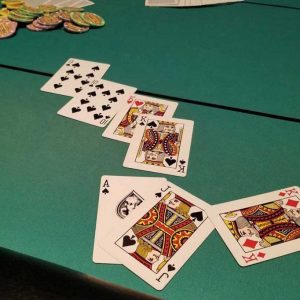Introduction to Bluffing in Seven Card Stud – Part I

I’m often told by players new to the game of 7 Card Stud that the game is just a card catching game. They believe that there are very few spots in which one can bluff in the game, and that is just not the case. In fact, an observant player can find situations on almost every street. Let’s take a look at some of those scenarios. This week, we will cover bluffing through fifth street.
Third Street – Ante Stealing
The most common form of bluff done on third street is the ante steal. Unlike Hold’em, you can see one-third of your opponent’s cards on third street. This gives players with high cards a distinct advantage to start with. This advantage grows if that advantage is in late position.
When an ante steal is performed, commonly it will be done by a person completing with the highest card on board. For example, if your door card Ks is the highest card, you very well may take down the antes and the bring-in with a completion. The chances of this play working increases when nobody else holds your card or when you are in late position.
Late position players will be your next most common ante stealer. If action is folded to them with and only the bring-in or other cards lower than their door card left to act, then you may see them complete the bet. Again, this works best when no one is showing your card.
Fourth Street – High Card Bluffing
A common bluff on fourth street in Stud is customarily done in heads-up pots. It involves a player with a card 10 or higher limping in behind the bring-in. If they catch any face card or if the bring-in catches another low card with his bring-in card, they will throw out a bet.
The power behind this bet is that you do not know if the player is drawing or if they held three random high cards and just hit a pair. At the same time, your opponent is banking on the fact that your card on fourth street did not help your hand, and even if it did, they are hoping that their representation of a larger pair pushes you off the hand.
Fifth Street Bluffing
Fifth street is when players make the decision to stay in the hand until the end or fold. It is also a street that will allow you to expand your bluffing. The first, and most common, form of bluffing revolve around straight and flushes. There are many cases where you will see a player bet out on fifth street after catching a third card to a straight, such as K-Q-J, or three suited cards.
You will often hear that someone is “representing a hand” when they bet here. If an opponent who was being aggressive slows down on fifth after seeing a third straight or flush card hit, you can bet a bluff is coming. A variation on this is when players decide to raise either as a semi-bluff or based on the strength of their board.
Another regular bluff you will encounter is what I like to call the “pairing your door card bluff.” This bluff is difficult to defend against unless you have plenty of information. The reason is that it is a general rule in stud that if a player hits their door card, they just hit trips.
If a player pairs their door card on fifth, you will likely see a bet out of them regardless of whether they have trips or not. This bluff will work more often when none of their outs have already hit or if someone slows down their betting. If this situation arises, it is really hard to call that bet with an inferior hand unless you are pretty certain they did not start with that pair or you have a draw to a monster yourself.
Next week, we will look at bluffing on sixth and seventh streets.
